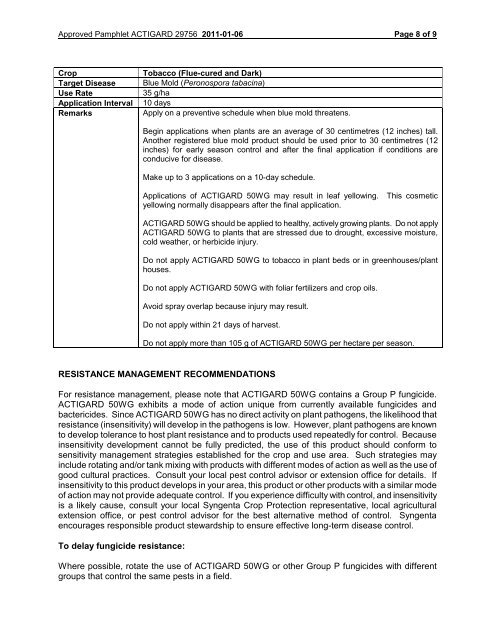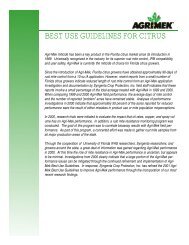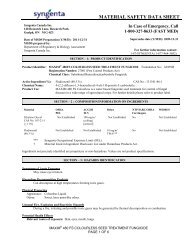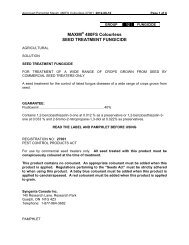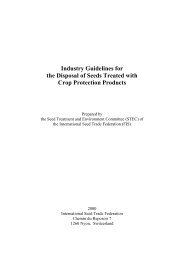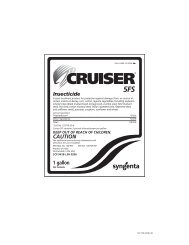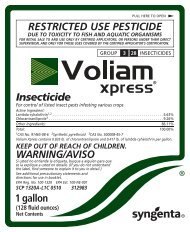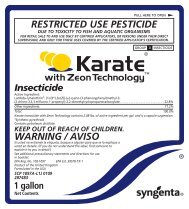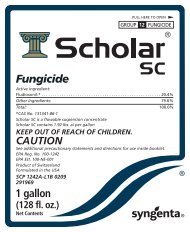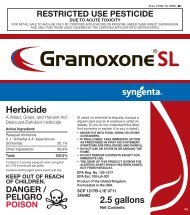QUADRIS - Syngenta Crop Protection
QUADRIS - Syngenta Crop Protection
QUADRIS - Syngenta Crop Protection
Create successful ePaper yourself
Turn your PDF publications into a flip-book with our unique Google optimized e-Paper software.
Approved Pamphlet ACTIGARD 29756 2011-01-06 Page 8 of 9<br />
<strong>Crop</strong> Tobacco (Flue-cured and Dark)<br />
Target Disease Blue Mold (Peronospora tabacina)<br />
Use Rate 35 g/ha<br />
Application Interval 10 days<br />
Remarks Apply on a preventive schedule when blue mold threatens.<br />
Begin applications when plants are an average of 30 centimetres (12 inches) tall.<br />
Another registered blue mold product should be used prior to 30 centimetres (12<br />
inches) for early season control and after the final application if conditions are<br />
conducive for disease.<br />
Make up to 3 applications on a 10-day schedule.<br />
Applications of ACTIGARD 50WG may result in leaf yellowing. This cosmetic<br />
yellowing normally disappears after the final application.<br />
ACTIGARD 50WG should be applied to healthy, actively growing plants. Do not apply<br />
ACTIGARD 50WG to plants that are stressed due to drought, excessive moisture,<br />
cold weather, or herbicide injury.<br />
Do not apply ACTIGARD 50WG to tobacco in plant beds or in greenhouses/plant<br />
houses.<br />
Do not apply ACTIGARD 50WG with foliar fertilizers and crop oils.<br />
Avoid spray overlap because injury may result.<br />
Do not apply within 21 days of harvest.<br />
Do not apply more than 105 g of ACTIGARD 50WG per hectare per season.<br />
RESISTANCE MANAGEMENT RECOMMENDATIONS<br />
For resistance management, please note that ACTIGARD 50WG contains a Group P fungicide.<br />
ACTIGARD 50WG exhibits a mode of action unique from currently available fungicides and<br />
bactericides. Since ACTIGARD 50WG has no direct activity on plant pathogens, the likelihood that<br />
resistance (insensitivity) will develop in the pathogens is low. However, plant pathogens are known<br />
to develop tolerance to host plant resistance and to products used repeatedly for control. Because<br />
insensitivity development cannot be fully predicted, the use of this product should conform to<br />
sensitivity management strategies established for the crop and use area. Such strategies may<br />
include rotating and/or tank mixing with products with different modes of action as well as the use of<br />
good cultural practices. Consult your local pest control advisor or extension office for details. If<br />
insensitivity to this product develops in your area, this product or other products with a similar mode<br />
of action may not provide adequate control. If you experience difficulty with control, and insensitivity<br />
is a likely cause, consult your local <strong>Syngenta</strong> <strong>Crop</strong> <strong>Protection</strong> representative, local agricultural<br />
extension office, or pest control advisor for the best alternative method of control. <strong>Syngenta</strong><br />
encourages responsible product stewardship to ensure effective long-term disease control.<br />
To delay fungicide resistance:<br />
Where possible, rotate the use of ACTIGARD 50WG or other Group P fungicides with different<br />
groups that control the same pests in a field.


